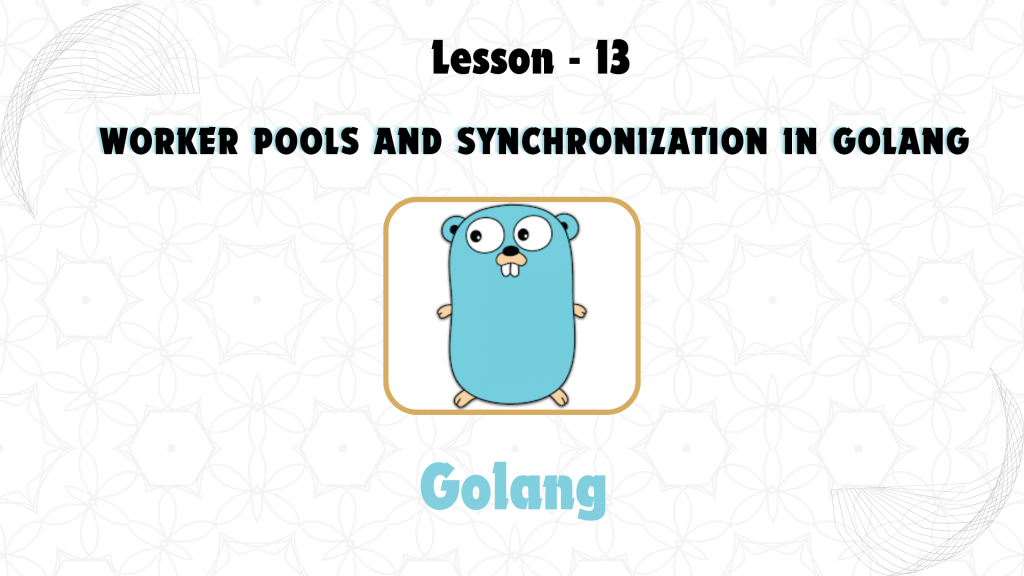
In GoLang, concurrency is a powerful feature that allows the efficient execution of multiple tasks in parallel. Worker pools and synchronization mechanisms such as WaitGroups and Rate Limiting help you manage and control concurrent operations in Go. This lesson covers how to implement worker pools, synchronize goroutines, and limit the rate of execution in concurrent programs.
1. Worker Pools in GoLang
A worker pool is a collection of goroutines that wait for tasks to execute concurrently. It is useful when you have a fixed number of tasks but want to limit the number of goroutines executing at any given time to avoid overwhelming system resources.
Steps to Create a Worker Pool:
- Task Channel: A channel is used to send tasks to the worker goroutines.
- Worker Goroutines: Each worker is a goroutine that processes tasks from the channel.
- Synchronization: After completing all tasks, you need to ensure the main goroutine waits for all workers to finish, typically done using a WaitGroup.
Example:
package main
import (
"fmt"
"sync"
"time"
)
// Worker function to process tasks
func worker(id int, tasks <-chan int, wg *sync.WaitGroup) {
defer wg.Done()
for task := range tasks {
fmt.Printf("Worker %d started task %d\n", id, task)
time.Sleep(time.Second) // Simulate work
fmt.Printf("Worker %d finished task %d\n", id, task)
}
}
func main() {
const numWorkers = 3
tasks := make(chan int, 10)
var wg sync.WaitGroup
// Start worker goroutines
for i := 1; i <= numWorkers; i++ {
wg.Add(1)
go worker(i, tasks, &wg)
}
// Send tasks to the worker pool
for i := 1; i <= 10; i++ {
tasks <- i
}
close(tasks) // Close the channel after sending all tasks
// Wait for all workers to finish
wg.Wait()
fmt.Println("All tasks completed")
}
Explanation:
- We create 3 workers, each running in its own goroutine. Each worker waits for tasks from the
taskschannel. - Tasks (numbers from 1 to 10) are sent to the workers.
sync.WaitGroupensures that the main function waits for all the workers to finish before terminating.
2. Using WaitGroups for Synchronization
The sync.WaitGroup is a simple and effective way to wait for a collection of goroutines to finish their execution. It allows you to add the number of goroutines you’re waiting for and block the main goroutine until all are complete.
Key Functions:
wg.Add(n): Addsngoroutines to the WaitGroup counter.wg.Done(): Decreases the counter by one (used inside each goroutine).wg.Wait(): Blocks the main goroutine until the WaitGroup counter reaches zero.
3. Rate Limiting in GoLang
Rate limiting ensures that a system does not get overwhelmed by too many requests or tasks at once. It controls the frequency of execution of tasks, which can be particularly useful in APIs, servers, or systems that require throttling of tasks to prevent overloading.
Basic Rate Limiting with Tickers: GoLang’s time.Ticker can be used to implement rate limiting by allowing only a certain number of tasks to execute within a given time interval.
Example:
package main
import (
"fmt"
"time"
)
func main() {
requests := make(chan int, 5)
// Simulate requests
for i := 1; i <= 5; i++ {
requests <- i
}
close(requests)
limiter := time.NewTicker(200 * time.Millisecond)
for req := range requests {
<-limiter.C
fmt.Println("Processing request", req, "at", time.Now())
}
}
Explanation:
- The
limiteris a ticker that allows one request to be processed every 200 milliseconds. - The rate limiting mechanism ensures that only one task is handled at a time within this interval.
4. Burst Rate Limiting
Sometimes, you need to handle occasional bursts of requests, followed by steady processing. For this, GoLang provides a token bucket approach where you can allow bursts up to a certain capacity and then revert to normal rate limiting.
Example:
package main
import (
"fmt"
"time"
)
func main() {
requests := make(chan int, 5)
// Simulate requests
for i := 1; i <= 5; i++ {
requests <- i
}
close(requests)
// Allow bursts of up to 3 requests
burstLimiter := make(chan time.Time, 3)
for i := 0; i < 3; i++ {
burstLimiter <- time.Now()
}
limiter := time.NewTicker(200 * time.Millisecond)
go func() {
for t := range limiter.C {
burstLimiter <- t
}
}()
for req := range requests {
<-burstLimiter
fmt.Println("Processing request", req, "at", time.Now())
}
}
Explanation:
- The
burstLimiterallows up to 3 requests to be processed immediately before the rate limiting kicks in, ensuring that bursts are handled efficiently.
5. Combining Worker Pools with Rate Limiting
You can combine worker pools and rate limiting to manage high-throughput tasks while avoiding overloading the system.
Example:
package main
import (
"fmt"
"sync"
"time"
)
func worker(id int, tasks <-chan int, wg *sync.WaitGroup, limiter <-chan time.Time) {
defer wg.Done()
for task := range tasks {
<-limiter
fmt.Printf("Worker %d processing task %d at %v\n", id, task, time.Now())
time.Sleep(time.Second)
}
}
func main() {
tasks := make(chan int, 10)
limiter := time.Tick(500 * time.Millisecond)
var wg sync.WaitGroup
for i := 1; i <= 3; i++ {
wg.Add(1)
go worker(i, tasks, &wg, limiter)
}
for i := 1; i <= 10; i++ {
tasks <- i
}
close(tasks)
wg.Wait()
fmt.Println("All tasks completed")
}
Explanation:
- This example demonstrates how worker pools can be throttled using rate limiting to ensure that tasks are processed at a steady rate, preventing the workers from overwhelming the system.
Key Takeaways:
- Worker Pools allow you to control the number of concurrent tasks being processed at any given time.
- WaitGroups ensure synchronization between goroutines, allowing the main function to wait until all tasks are completed.
- Rate Limiting ensures tasks are executed within controlled time intervals to avoid overloading the system.
- Burst Rate Limiting allows for handling bursts of tasks while maintaining control over the task flow.
Combining these concepts enables you to build scalable, efficient, and well-controlled concurrent applications in GoLang.


